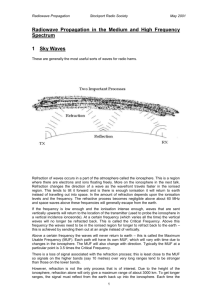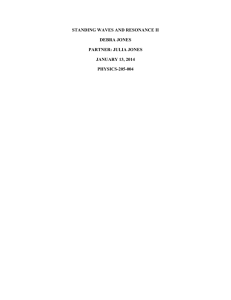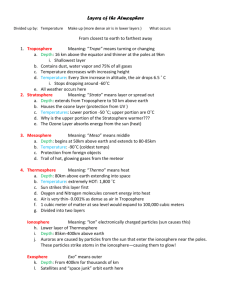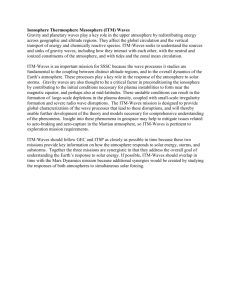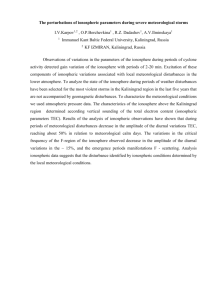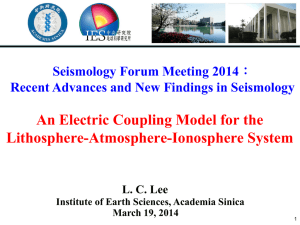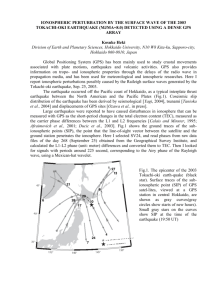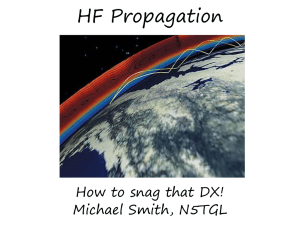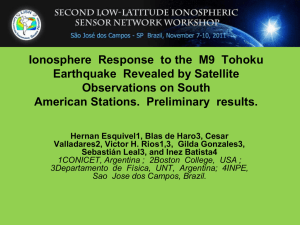Introduction to HF Radio Propagation
advertisement
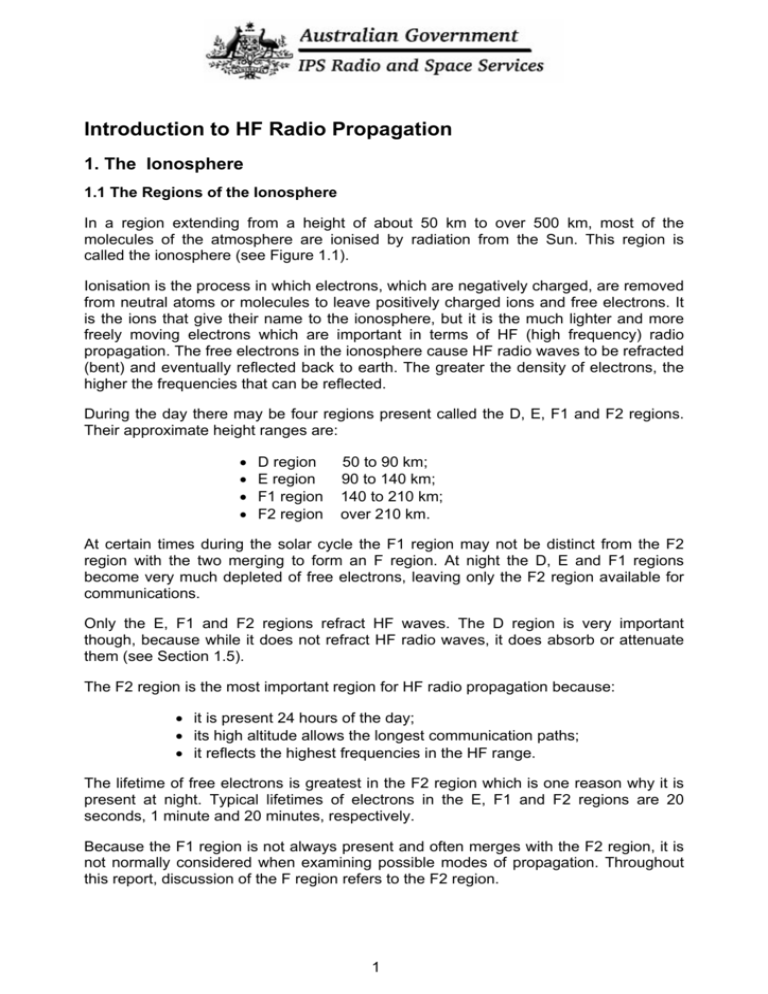
Introduction to HF Radio Propagation 1. The Ionosphere 1.1 The Regions of the Ionosphere In a region extending from a height of about 50 km to over 500 km, most of the molecules of the atmosphere are ionised by radiation from the Sun. This region is called the ionosphere (see Figure 1.1). Ionisation is the process in which electrons, which are negatively charged, are removed from neutral atoms or molecules to leave positively charged ions and free electrons. It is the ions that give their name to the ionosphere, but it is the much lighter and more freely moving electrons which are important in terms of HF (high frequency) radio propagation. The free electrons in the ionosphere cause HF radio waves to be refracted (bent) and eventually reflected back to earth. The greater the density of electrons, the higher the frequencies that can be reflected. During the day there may be four regions present called the D, E, F1 and F2 regions. Their approximate height ranges are: • • • • D region E region F1 region F2 region 50 to 90 km; 90 to 140 km; 140 to 210 km; over 210 km. At certain times during the solar cycle the F1 region may not be distinct from the F2 region with the two merging to form an F region. At night the D, E and F1 regions become very much depleted of free electrons, leaving only the F2 region available for communications. Only the E, F1 and F2 regions refract HF waves. The D region is very important though, because while it does not refract HF radio waves, it does absorb or attenuate them (see Section 1.5). The F2 region is the most important region for HF radio propagation because: • it is present 24 hours of the day; • its high altitude allows the longest communication paths; • it reflects the highest frequencies in the HF range. The lifetime of free electrons is greatest in the F2 region which is one reason why it is present at night. Typical lifetimes of electrons in the E, F1 and F2 regions are 20 seconds, 1 minute and 20 minutes, respectively. Because the F1 region is not always present and often merges with the F2 region, it is not normally considered when examining possible modes of propagation. Throughout this report, discussion of the F region refers to the F2 region. 1 Day ionosphere Night ionosphere exosphere satellite 500 - thermosphere Altitude/(km) 400 - F2 layer 300 F layer F1 layer 200 - sporadic E E layer sporadic E meteor 100 mesosphere D region 0 balloon 10 102 103 104 105 106 107 0 10 102 103 104 Electron density/(electrons/cm3) stratosphere troposphere 5 10 106 107 Figure 1.1 Day and night structure of the ionosphere. 1.2 Production and Loss of Electrons Radiation from the Sun causes ionisation in the ionosphere. Electrons are produced when solar radiation collides with uncharged atoms and molecules (Figure 1.2). Since this process requires solar radiation, production of electrons only occurs in the daylight hemisphere of the ionosphere. Loss of free-electrons in the ionosphere occurs when a free electron combines with a charged ion to form a neutral particle (Figure 1.3). Loss of electrons occurs continually, both day and night. free electron uncharged atom solar radiation charged atom Figure 1.2 Free electron production in the ionosphere 2 free electron uncharged atom charged atom (ion) Figure 1.3 Loss of free-electrons in the ionosphere. 1.3 Observing the Ionosphere The most important feature of the ionosphere in terms of radio communications is its ability to reflect radio waves. However, only those waves within a certain frequency range will be reflected. The range of frequencies reflected depends on a number of factors (see Section 1.4). Various methods have been used to investigate the ionosphere, and the most widely used instrument for this purpose is the ionosonde (Figure 1.4). An ionosonde is a high frequency radar which sends very short pulses of radio energy vertically into the ionosphere. If the radio frequency is not too high, the pulses are reflected back towards the ground. The ionosonde records the time delay between transmission and reception of the pulses over a range of different frequencies. Echoes appear first from the lower E region and subsequently, with greater time delay, from the F1 and F2 regions. At night echoes are returned only from the F region since the E region is not present. 3 Ionosphere pulse Rx delta antenna Tx delta antenna Figure 1.4 Ionosonde operation. Today, the ionosphere is “sounded” not only by signals sent up at vertical incidence but by oblique sounders which send pulses obliquely into the ionosphere with the transmitter and receiver separated by some distance. This type of sounder can monitor propagation on a particular circuit and observe the various modes being supported by the ionosphere (see Section 2.5). Backscatter ionosondes rely on echoes reflected from the ground and returned to the receiver, which may or may not be at the same site as the transmitter. This type of sounder is used for over-the-horizon radar. 1.4 Ionospheric Variations The ionosphere is not a stable medium that allows the use of the same frequency throughout the year, or even over 24 hours. The ionosphere varies with the solar cycle, the seasons and during any given day. 1.4.1 Variations due to the Solar Cycle The Sun goes through a periodic rise and fall in activity which affects HF communications; solar cycles vary in length from 9 to 14 years. At solar minimum, only the lower frequencies of the HF band will be supported (reflected) by the ionosphere, while at solar maximum the higher frequencies will successfully propagate (Figure 1.5). This is because there is more radiation being emitted from the Sun at solar maximum, producing more electrons in the ionosphere which allows the use of higher frequencies. 4 Canberra 16 160 Sunspot number 120 foF2 8 80 Sunspot no. Frequency/(MHz) 12 foF1 40 4 foE 0 0 88 90 92 foF2 94 96 Year foF1 98 00 foE 02 04 Sunspot number Figure 1.5 The relationship between solar cycles and maximum frequencies supported by E, F1 and F2 regions. Vertical lines indicate the start of each year. Note also the seasonal variations. There are other consequences of the solar cycle. Around solar maximum there is a greater likelihood of large solar flares occurring. Flares are huge explosions on the Sun which emit radiation that ionises the D region, causing increased absorption of HF waves. Since the D region is present only during the day, only those communication paths which pass through daylight will be affected. The absorption of HF waves travelling via the ionosphere after a flare has occurred is called a short wave fade-out (see Section 3.1). Fade-outs occur instantaneously and affect lower frequencies the most. If it is suspected or confirmed that a fade-out has occurred, it is advisable to try using a higher frequency. The duration of fade-outs can vary between about 10 minutes to several hours, depending on the duration and intensity of the flare. 1.4.2 Seasonal Variations E region frequencies are greater in summer than winter (see Figure 1.5). However, the variation in F region frequencies is more complicated. In both hemispheres, F region noon frequencies generally peak around the equinoxes (March and September). Around solar minimum the summer noon frequencies are, as expected, generally greater than those in winter, but around solar maximum winter frequencies tend to be higher than those in summer. In addition, frequencies around the equinoxes (March and September) are higher than those in summer or winter for both solar maximum and minimum. The observation of winter frequencies often being greater than those in summer is called the seasonal anomaly. 5 1.4.3 Variations with Latitude Figure 1.6 shows the variations in the E and F region maximum frequencies at mid-day (Day hemisphere) and mid-night (Night hemisphere) from the pole to the equator. During the day, with increasing latitude, the solar radiation strikes the atmosphere more obliquely, so the intensity of radiation and the daily production of free electrons decreases with increasing latitude. In the F region this latitude variation persists throughout the night due to the action of upper atmospheric wind currents from day-lit to night-side hemispheres (see for example, IPS HF Radio Propagation Course and Manual - http://www.ips.gov.au/Products_and_Services/2/2). 12 equatorial anomaly 10 8 F 6 4 0 20 40 60 80 equator E mid-latitude trough pole 2 equator Highest usable frequency (MHz) Night hemisphere Day hemisphere 80 60 40 20 0 Geomagnetic latitude (degrees) Figure 1.6 Latitudinal variations. Deviations from the general low to high latitude decrease are also apparent. Daytime F region frequencies peak not at the geomagnetic equator, but 15 to 20° north and south of it. This is called the equatorial anomaly. Also, at night, frequencies reach a minimum around 60° latitude north and south of the geomagnetic equator. This is called the midlatitude trough. Communicators who require communications near the equator during the day and around 60° latitude at night, should be aware of these characteristics. For example, from Figure 1.6 one can see how rapidly the frequencies can change with latitude near the mid-latitude trough and equatorial anomaly, so a variation in the reflection point near these by a few degrees may lead to a large variation in the frequency supported. 6 1.4.4 Daily Variations Frequency/(MHz) Frequencies are normally higher during the day and lower at night (Figure 1.7). After dawn, solar radiation causes electrons to be produced in the ionosphere and frequencies increase rapidly to a maximum around noon. During the afternoon, frequencies begin falling due to electron loss and with darkness the D, E and F1 regions disappear. Communication during the night is by the F2 (or just F) region only and attenuation is very low. Through the night, maximum frequencies gradually decrease, reaching their minimum just before dawn. 15 12 9 6 3 0 0 2 4 6 8 10 12 14 16 18 20 22 24 Local time/(hours) E F1 F2 Figure 1.7 E, F1 and F2 layer maximum frequencies throughout the day. 1.5 Variations in Absorption Absorption was discussed in section 1.4.1 in relation to solar flares. Whilst absorption is extremely high during a solar flare, a certain amount of D region absorption occurs all the time. Absorption in the D region varies with the solar cycle, being greatest around solar maximum. Signal absorption is also greater in summer and during the middle of the day (Figure 1.8). There is a variation in absorption with latitude, with more absorption occurring near the equator and decreasing towards the poles. Lower frequencies are absorbed the most so it is always advisable to use the highest frequency possible, particularly during the day when absorption is greatest. 7 Vertical absorption/(dB) 50 summer (December 1980) 40 winter (June 1980) 30 20 10 0 2 4 6 8 10 12 14 16 18 20 22 24 Time/(LT) Figure 1.8 Daily and seasonal variations in absorption at Sydney, 2.2 MHz. Sometimes, high energy protons are ejected from the Sun during large solar flares. These protons move down the Earth’s magnetic field lines, into the polar regions and cause massive ionization of the polar D region leading to increased or total absorption of HF waves. This effect may last for as long as 10 days and is called a Polar Cap Absorption event (PCA) (see Section 3.2). 1.6 Sporadic E Sporadic E refers to the largely unpredictable formation of regions of very high electron density in the E region. Sporadic E may form at any time during the day or night occurring at altitudes of 90 to 140 km (the E region). It varies greatly in the area it covers (a few km to hundreds) and the time it persists for (minutes to many hours). Sporadic E can have a comparable electron density to the F region which means it can reflect the sort of high frequencies intended for F region communications. Sometimes a sporadic E layer is transparent and allows most of the radio wave to pass through it to the F region, however, at other times the sporadic E layer obscures the F region totally and the signal does not reach the F region and hence the receiver (sporadic E blanketing). If the sporadic E layer is partially transparent, the radio wave is likely to be reflected at times from the F region and at other times from the sporadic E region. This may lead to partial or intermittent transmission of the signal or fading (Figure 1.9). Sporadic E in the low and mid-latitudes occurs mostly during the daytime and early evening, and is more prevalent during the summer months. At high latitudes, sporadic E tends to form at night. 8 F region 1F E region sporadic E Figure 1.9 Sporadic E formation (night or day) may result in communications via the F region being interrupted if the sporadic E electron density is high enough to reflect the wave. 1.7 Spread F Spread F occurs when the F region becomes diffuse due to irregularities which scatter the radio wave. The received signal is the superposition of a number of waves reflected from different heights and locations in the ionosphere at slightly different times. At low latitudes, spread F occurs mostly during the night hours and around the equinoxes. At mid-latitudes, spread F is less likely to occur than at low and high latitudes and is more likely to occur at night and in winter. At latitudes greater than about 40°, spread F tends to be a night time phenomenon, appearing mostly around the equinoxes, while around the magnetic poles, spread F is often observed both day and night. At all latitudes there is a tendency for spread F to occur when there is a decrease in F region maximum frequencies (reduced electron density). That is, spread F is often associated with ionospheric storms (see Section 3.3). 9 2. HF Communications 2.1 Types of HF Propagation High Frequency (3 to 30 MHz) radio signals can propagate to a distant receiver, Figure 2.1, via the: • ground wave: near the ground for short distances, up to 100 km over land and 300 km over sea. Attenuation of the wave depends on antenna height, polarisation, frequency, ground types, terrain and/or sea state; • direct or line-of-sight wave: this wave may interact with the earth-reflected wave depending on terminal separation, frequency and polarisation; • sky wave: reflected by the ionosphere; all distances. 2.2 Frequency Limits of Sky Waves Not all HF waves are reflected by the ionosphere; there are upper and lower frequency bounds for communications between two terminals. If the frequency is too high, the wave will pass straight through the ionosphere. If it is too low, the strength of the signal will be very low due to absorption in the D region. The range of usable frequencies will vary: • • • • throughout the day; with the seasons; with the solar cycle; from place to place; The upper limit of frequencies varies mostly with the above factors, while the lower limit also depends on receiver site noise, antenna efficiency, transmitter power, E layer screening (Section 2.6) and absorption by the ionosphere. 10 Ionosphere Sky wave Direct wave Ground wave Figure 2.1 Types of HF propagation. 2.3 The Usable Frequency Range For any circuit there is a Maximum Usable Frequency (MUF) which is determined by the state of the ionosphere in the vicinity of the reflection points and the length of the circuit. The MUF is reflected from the maximum electron density within a given layer of the ionosphere. Therefore, frequencies higher than the MUF for a particular region will penetrate through that region entirely. During the day it is possible to communicate via both the E and F layers using different frequencies. The highest frequency supported by the E layer is the EMUF, while that supported by the F layer is the FMUF. The F region MUF in particular varies greatly throughout the day, seasonally and with the solar cycle. Historical data collected over many years displays the full range of these variations for a given location. The historical data is averaged and organised to give a MUF for every hour of the day (24 values), for each month of the year. These can also be adjusted for the solar cycle. MUFs are quoted as a statistical range with the “lower decile” (also called the Optimum Working Frequency OWF) working 90% of the time, the “median” MUF working 50% of the time and the “upper decile” MUF working just 10% of the time. IPS predictions usually cover a period of one month, so the OWF for a given hour, should provide successful propagation 90% of the time or 27 days of the that month. The median MUF should provide communications on 15 days of the month and the upper decile MUF on just 3 days of the month. The upper decile MUF is the highest frequency of the range and is most likely to penetrate the ionosphere, thus only working 10% of the time (Figure 2.2). 11 Upper decile MUF (10% chance of success) F region f > EMUF f ≤ EMUF Median MUF (50% chance of success) OWF (90% chance of success) E region f near ALF Rx Tx Figure 2.2 Range of usable frequencies. If the frequency, f, is close to the ALF then the wave may suffer absorption in the D region. If the frequency is above the EMUF then propagation is via the F region. Above the FMUF the wave is likely to penetrate the ionosphere. The statistical MUFS described above correspond to “quiet background” conditions. With short-term variations in solar activity however, away from quiet background levels, usable frequencies change. This needs to be reflected in MUF predictions and one of the roles of the Australian Space Forecast Centre (ASFC) at IPS is to modify the historical MUFS to reflect the real-time observed space-weather conditions. Sophisticated techniques have been developed at IPS over many years to combine the effects of observed space-weather conditions with historically averaged data to provide detailed and accurate predictions of ionospheric conditions. D region absorption of HF radio waves increases rapidly with decreasing frequency. The D region thus places a lower limit on the frequencies which can be used for ionospheric propagation. This limit is called the Absorption Limiting Frequency (ALF). The ALF is significant only for circuits with reflection points in the sunlit hemisphere. At night, the ALF falls to zero, allowing frequencies which are not usable during the day to successfully propagate. 2.4 Hop Lengths The hop length is the ground distance covered by a radio signal after it has been reflected once from the ionosphere and returned to Earth (Figure 2.3). The maximum hop length is set by the height of the ionosphere and the curvature of the Earth. For E and F region heights of 100 km and 300 km, the maximum hop lengths are about 1800 km and 3200 km, respectively (corresponding to an elevation angle of around 4°). 12 Distances greater than these will require more than one hop. For example, a distance of 6100 km will require a minimum of 4 hops by the E region and 2 hops via the F region. More hops are required again with larger antenna elevation angles. F layer 300 km 100 km E layer 3200 km 1800 km Figure 2.3 Hop lengths based upon an antenna elevation angle of 4° and heights for the E and F layers of 100 km and 300 km, respectively. 2.5 Propagation Modes There are many paths by which a sky wave may travel from a transmitter to a receiver. The mode reflected by a particular layer which requires the least number of hops between the transmitter and receiver is called the first order mode. The mode that requires one extra hop is called the second order mode, and so on. For a circuit with a path length of 5000 km, the first order F mode has two hops (2F), while the second order F mode has three hops (3F). The first order E mode has the same number of hops as the first order F mode. If this results in a hop length of greater than 2050 km, which corresponds to an elevation angle of 0°, then the E mode is not possible. Simple modes are those propagated by one region, say the F region. IPS predictions are made only for these simple modes (Figure 2.4). More complicated modes consisting of combinations of reflections from the E and F regions, ducting and chordal modes are also possible (Figure 2.5). 13 F region 1F 2F E region 2E 1E Figure 2.4 Examples of simple propagation modes. Chordal modes and ducting involve a number of reflections/refractions from the ionosphere without intermediate reflections from the Earth. There is a tendency to think of the regions of the ionosphere as being smooth, however, the ionosphere undulates and moves, with waves passing through it which affects the refraction of radio signals. When ionospheric layers tilt chordal and ducted modes may occur. Ionospheric tilting is more likely near the equatorial anomaly, the mid-latitude trough and in the sunrise and sunset sectors of the globe. When these types of modes occur, signals can be strong since the wave spends less time traversing the D region or being attenuated by ground reflections. 14 ionospheric tilt F region chordal mode ducted mode sporadic E E region 1F1Es1F 1F1E Figure 2.5 Complex propagation modes. Because of the high electron density of the daytime ionosphere around 15° from the magnetic equator (near the equatorial anomaly), trans-equatorial paths can propagate on very high frequencies. Any tilting of the ionosphere in this region may result in chordal modes (see Figure 2.5) which produce good signal strength over very long distances. Ducting may also result if tilting occurs and the wave becomes trapped between reflecting regions of the ionosphere (see Figure 2.5). This is most likely to occur in the equatorial ionosphere, near the auroral zone and mid-latitude trough. Disturbances to the ionosphere, such as travelling ionospheric disturbances (see Section 2.9), may also initiate ducting and chordal modes. 2.6 E Layer Screening For daytime communications via the F region, the lowest usable frequency via the one hop F mode (1F) is dependent upon the presence of the E region. If the operating frequency is below the two hop EMUF, then the signal will propagate via the 2E mode rather than the 1F mode (Figure 2.6). This is also because the antenna elevation angles of the 1F and 2E modes are similar. 15 F region 1F f > 2 hop EMUF E region 2E f < 2 hop EMUF Figure 2.6 E layer screening occurs if communications are intended by the 1F mode but the operating frequency is close to or below the EMUF for the 2E mode. Note that the 2 hop E mode travels twice as many times through the D region. A sporadic E layer may also screen a HF wave from the F region. Sometimes sporadic E can be quite transparent, allowing most of the wave to pass through it. At other times it will partially screen the F region leading to a weak or fading signal, while at other times sporadic E can totally obscure the F region with the result that the signal does not arrive at the receiver (Figure 1.9). 2.7 Frequency, Range and Elevation Angle For HF propagation path, there are three dependent variables: • frequency; • range or path length; • antenna elevation angle. The diagrams below illustrate the possible changes to the ray paths when each of these is fixed in turn. 16 Figure 2.7: Elevation angle fixed: • As the frequency is increased toward the MUF, the wave is reflected higher in the ionosphere and the range increases; paths 1 and 2 • Exactly at the MUF, the maximum range is reached; path 3 • Above the MUF, the wave penetrates the ionosphere; path 4 4. frequency too high ionosphere 3. high frequency 1. low frequency 2. intermediate frequency Figure 2.7 Elevation angle fixed. Figure 2.8: Path length fixed (point-to-point circuit): • As the frequency is increased towards the MUF, the wave is reflected from higher in the ionosphere. To maintain a circuit of fixed length, the elevation angle must therefore be increased (paths 1 and 2) • At the MUF, the critical elevation angle is reached (path 3). The critical elevation angle is the highest elevation angle for a particular frequency. • Above the MUF, the ray penetrates the ionosphere (path 4). 17 3. higher frequency - this frequency becomes the MUF for this circuit. 4. highest frequency ionosphere 1. lower frequency 2. intermediate frequency Figure 2.8 Path length fixed. Figure 2.9: Frequency fixed: • At low elevation angles the path length is greatest (path 1); • As the elevation angle is increased, the path length decreases and the ray is reflected from higher in the ionosphere (paths 2 and 3); • If the elevation angle is increased beyond the critical elevation angle for that frequency then the wave penetrates the ionosphere and there is an area around the transmitter within which no sky wave communications can be received (path 4). To communicate within this so called “skip zone”, the frequency must be lowered. • If a signal of a certain frequency is reflected when vertically incident on the ionosphere, then there is no skip zone. The vertically incident maximum frequency is referred to as f0F2 and is a key ionospheric parameter. 18 4 ionosphere 3 skip zone results 2 1 Figure 2.9 Frequency fixed. 2.8 Skip Zones Skip zones can often be used to advantage if it is desired that communications are not heard by a particular receiver. Selecting a frequency which puts a receiver in the skip zone and out of reach of the ground wave makes it unlikely that it will receive the communications. However, factors such as sidescatter, where reflection from the Earth outside the skip zone results in the wave transmitting into the skip zone may affect the reliability of this. Skip zones vary in size during the day, with the seasons, and with solar activity. During the day, solar maximum and around the equinoxes, skip zones generally are smaller in area. The ionosphere during these times has increased electron density and so is able to support higher frequencies. 2.9 Fading Multipath fading results when a number of modes propagate from transmitter to receiver, which have variations in phase and amplitude. See for example, Figure 2.4. The signal travels by a number of paths simultaneously which may interfere at the receiver, causing fading. Disturbances known as Travelling Ionospheric Disturbances (TID), may cause a region to be tilted, resulting in the signal being focussed or defocused (Figure 2.10). Fading periods of the order of 10 minutes or more can be associated with these structures. TIDs travel horizontally at 5 to 10 km/minute with a well defined direction of travel and 19 affect higher frequencies first. Some originate in auroral zones following an event on the Sun and these may travel large distances. Others originate in lower atmospheric weather disturbances. TIDs may cause variations in phase, amplitude, polarisation and angle of arrival of a radio wave. Polarisation fading results from changes to the polarisation of the wave along the propagation path with the receiving antenna being unable to receive parts of the signal. This type of fading can last for a fraction of a second to a few seconds. Skip fading often occurs around sunrise and sunset when the ionosphere is at its most unstable. If the operating frequency is close to the MUF and the receiving antenna is positioned close to the boundary of the skip zone then signal will fade in and out with fluctuations in the ionosphere. focussing defocussing Figure 2.10 Focussing and defocussing effects caused by travelling ionospheric disturbances (TIDs). 2.10 Noise Radio noise arises from internal and external origins. Internal or thermal noise is generated in the receiving system and is usually negligible for a good quality receiver when compared to external sources of noise. External radio noise originates from natural (atmospheric and galactic) and man-made (environmental) sources. Atmospheric noise, which is caused by thunderstorms, is normally the major contributor to radio noise in the HF band and will especially degrade circuits passing through the day-night interface. Atmospheric noise is greatest in the equatorial regions and decreases with increasing latitude. Its effect is also greater on lower frequencies so is 20 usually more of a problem around solar minimum and at night when lower frequencies are needed. Galactic noise arises from our galaxy. Since only the highest frequencies will pass through the ionosphere (from above) galactic noise only effects high frequencies. Man-made noise results from any large currents and voltages such as ignition systems, neon signs, electrical cables, power transmission lines and welding machines. This type of noise depends on the technology used by the society and its population. Interference may be intentional (jamming), due to propagation conditions or the result of others operating on the same frequency. Man-made noise tends to be vertically polarised, so selecting a horizontally polarised antenna may help in reducing man-made noise. Using a narrower bandwidth, or a directional receiving antenna (with a lobe in the direction of the transmitting source and a null in the direction of the unwanted noise source), will also aid in reducing the effects of noise. Selecting a site with a low noise level and determining the major noise sources are important factors in establishing a successful communications system. 2.11 VHF and 27 MHz Propagation VHF and 27 MHz are used for line-of-sight or direct wave communication, for example, ship-to-ship or ship-to-shore. The frequency bands are divided into channels and one channel is usually as good as the next. This is in contrast to medium frequency (MF: 300 kHz to 3 MHz) and HF where the choice of a frequency channel may be crucial for good communications. Because VHF and 27 MHz operate mainly by line-of-sight, it is important to mount the antenna as high as possible and free from obstructions. Shore stations are usually on the tops of hills to provide maximum range, but even the highest hills do not provide coverage beyond about 45 nautical miles (80 km), because of the Earth’s curvature. Antennas for VHF and 27 MHz should usually concentrate radiation at low angles (towards the horizon) as except when communicating with aircraft, radiation directed at high angles will pass over the receiving antenna. VHF and 27 MHz do not usually suffer from atmospheric noise except during severe electrical storms. Interference mainly results from many users wishing to use the limited number of channels, and this can be a significant problem in densely populated areas. 27 MHz and the lower frequencies in the VHF band can, at times, propagate over large distances, well beyond the normal line-of-sight limitations. There are three ways that this can take place: • around solar maximum and during the day, the ionospheric F region will often support long range sky wave communications on 27 MHz and above; • sporadic E layers can often support 27 MHz and lower frequency VHF propagation over circuits of about 500 to 1000 nautical miles (1000 to 2000 km) in length. This kind of propagation is most likely to occur at mid-latitudes, during the daytime in summer; • 27 MHz and VHF can also propagate by means of temperature inversions (ducting) at altitudes of a few kilometres. Under these conditions, the waves are gradually 21 bent by the temperature inversion to follow the curvature of the Earth. Distances of several hundred nautical miles can be covered in this way. 2.12 Medium Frequency (MF) Sky Wave Propagation Both the MF (300 kHz to 3 MHz) and HF bands can be used for long distance sky wave communications at night. During the night the D region disappears, so absorption falls to very low levels. This is why radio broadcast stations operating in the MF and 4 MHz bands can be heard over long distances only at night. 2.13 Ground Wave MF and HF Propagation It is possible to communicate up to distances of several hundred nautical miles on MF/HF bands at sea by using ground wave propagation. The ground wave follows the curvature of the Earth and its range does not depend upon the height of the antenna. However, the range does depend upon the transmitter power and also upon the operating frequency. Low frequencies travel further than high frequencies. Thus under ideal (midday, during winter) low noise conditions, it is possible to communicate over distances of about 500 nautical miles at 2 MHz by using a 100 W transmitter. At 8 MHz, under the same conditions and using the same transmitter power, the maximum range is reduced to about 150 nautical miles. Note that ground wave propagation is much less efficient over land than it is over sea because of the much lower conductivity of the ground and other factors. Consequently, ranges over land are greatly reduced compared to ranges over sea water. Ground wave communications vary daily and with the seasons. The greatest communication ranges are achieved during the daytime in winter because background noise levels are lowest at these times. Successful ground wave communications over hundreds of nautical miles can only be achieved if the transmitting and receiving antennas are chosen to direct and receive radiation at low angles. Tall whips are ideal for this purpose. 2.14 Universal Time Unless communications are always with another communicator on the same time standard, it is considered more convenient to work in universal (UT) or Zulu (Z) time since in many cases the transmitter and receiver are operating in different local time zones. Universal time is the same as the Greenwich Mean Time (GMT) and 0000 UT (0000 Z) is midnight at Greenwich, UK. For eastern Australia, operating on Eastern Standard Time (EST), 10 am EST equals 0000 UT. Western Australia is 8 hours ahead of Greenwich, UK, so 0800 WST = 0000 UT, and central Australia is 9.5 hours ahead of Greenwich (0930 CST = 0000 UT). 22 3. Summary of the Effects of Solar Disturbances 3.1 Short Wave Fade-outs (SWFs) Radiation from the Sun during large solar flares causes increased ionisation in the D region which results in higher absorption of HF radio waves (Figure 3.1). If the flare is large enough, the whole of the HF spectrum can be rendered unusable for a period of time. Fade-outs are more likely to occur around solar maximum than at solar minimum. The main features of SWFs are: • Only circuits with daylight sectors will be affected; • Fade-outs usually last from a few minutes to a few hours, with a fast onset and a slower recovery. The duration of the fade-out will depend on the duration of the flare; • The magnitude of the fade-out will depend on the size of the flare and the position of the Sun relative to the point where the radio wave passes through the D region. The higher the Sun with respect to that point, the greater the amount of absorption; • Absorption is greatest at lower frequencies, which are the first to be affected and the last to recover. Higher frequencies are normally less affected and may still be usable (Figure 3.2). Sun Flare X rays from flare site D region ionised heavily due to flare effects HF radio waves absorbed in D region Earth Figure 3.1 Fade-outs affect propagation of HF waves on the day-lit hemisphere. 23 20 MHz 10 MHz Signal strength 5 MHz ~ 1 hour Flare onset Time Figure 3.2 Fade-outs affect lower frequencies the most and these are the last to recover. Higher frequencies are least affected and sometimes unaffected by smaller flares. Short-wave fadeouts are also called daylight fade-outs or sudden ionospheric disturbances (SID). 3.2 Polar Cap Absorption Events (PCAs) PCAs are attributed to high energy protons which escape from the Sun when a large flare occurs and move along the Earth’s magnetic field lines to the polar regions. There they ionise the D region, causing very high absorption of HF waves. PCAs may commence as soon as 10 minutes after a flare and last for up to 10 days. Even the winter polar zone (a region of perpetual darkness) can suffer the effects of PCAs since the ionised D region is formed by protons rather than sunlight. The effects of PCAs can sometimes be overcome by relaying messages on circuits which do not require polar reflection points. PCAs are most likely to occur around solar maximum, however, they are not as frequent as fade-outs. 3.3 Ionospheric Storms Due to events on the Sun, sometimes the Earth’s magnetic field becomes disturbed. The geomagnetic field and the ionosphere are linked in complex ways and a disturbance in the geomagnetic field can often cause a disturbance in the ionosphere. 24 These disturbances, called ionospheric storms, sometimes begin with increased electron density allowing higher frequencies to be supported, followed by a decrease in the electron density leading to only low frequencies being supported by the ionosphere. An enhancement will not usually concern the HF communicator, but the depression may cause frequencies normally used for communication to be too high with the result that the wave penetrates the ionosphere. Ionospheric storms may last a number of days and higher latitudes are generally affected more than low latitudes. Unlike fade-outs, higher frequencies are most affected by ionospheric storms. To reduce the effects on communications of an ionospheric storm, a lower frequency should be used where possible. 25
